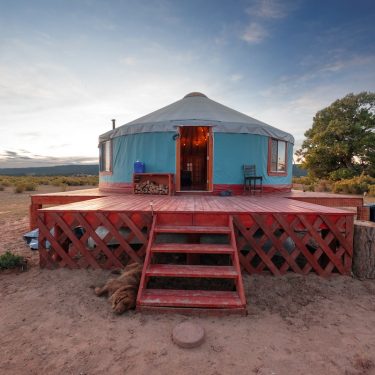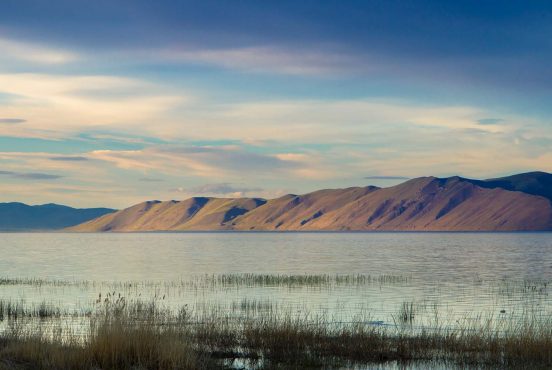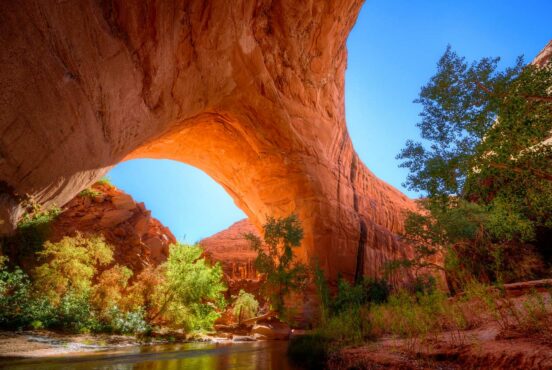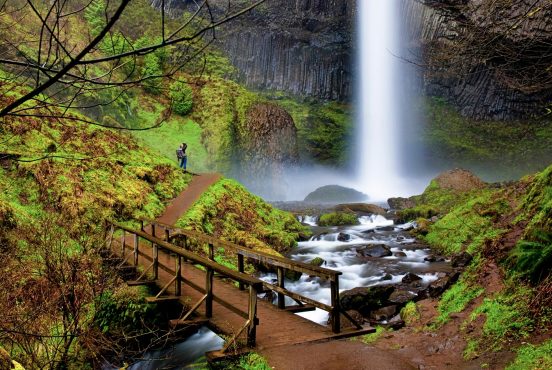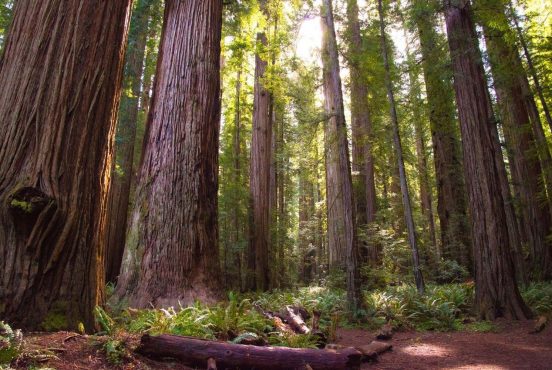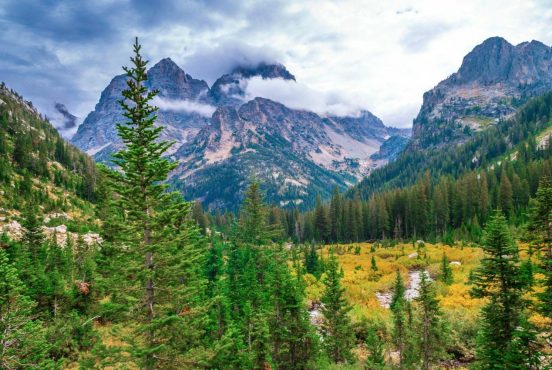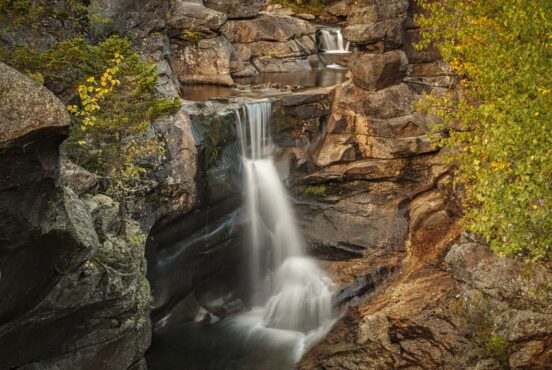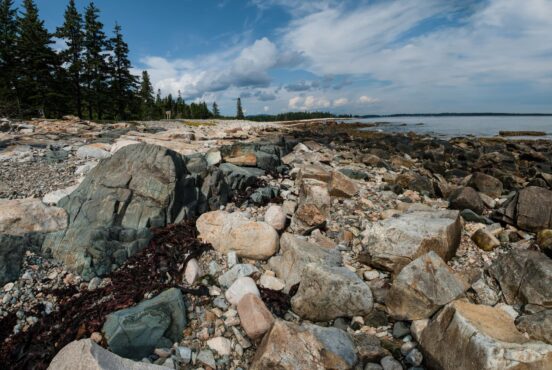Grand Canyon’s epic desert landscape attracts millions of visitors each year, but only the truly determined get enjoy its hidden waterfalls.
The quest to lay eyes on even one of the Grand Canyon’s waterfalls requires either hiking or rafting into wilderness. Even the “easiest” to get to — Vasey’s Paradise — requires committing to a minimum three-day rafting trip. Others require backpacking into the Canyon’s depth, where you’ll need to secure a backcountry camping permit.
Havasu Canyon is home to the most famous (and beautiful) waterfalls in Grand Canyon, and you’ll need a permit from the Havasupai tribe to visit. To visit the waterfalls in Grand Canyon National Park, you will likely need to secure an overnight permit from the National Park Service.
If you plan on rafting, be sure to ask the rafting company you wish to book with about how likely it is you will visit certain waterfalls on their trip — but the more leisurely the pace of the trip, the more likely you’ll be able to see places like Deer Creek Falls or Elves Chasm.
When adventuring in the Grand Canyon, always remember to follow Leave No Trace ethics so that our public lands remain pristine for the enjoyment by future generations.
Related Read: 21 Epic Arizona Waterfalls You Can Hike To
1. Fifty Foot Falls / New Navajo Falls
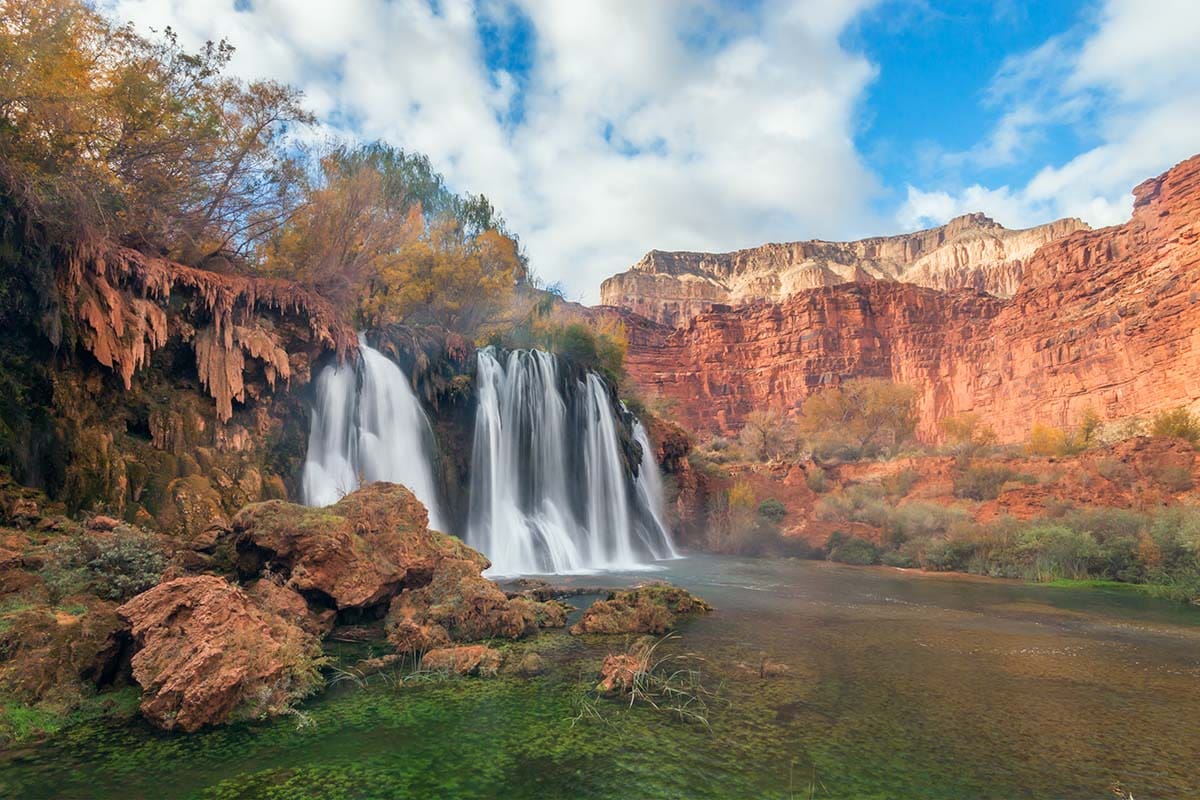
Havasu Canyon is home to Grand Canyon’s most famous and most beautiful waterfalls, and Fifty Foot Falls is my personal favorite in Havasupai. The upper-most of Havasu’s five major waterfalls, this beauty is easily accessible (once you’ve hiked over 9 miles into the canyon’s depths, of course) but is just far enough away from the main trail that it gets less attention than the other falls.
Fifty Foot Falls is also known as New Navajo Falls, but is often mistaken for the nearby Rock Falls, which is located less than a quarter-mile downstream. Prior to the massive flash flood of 2008, Fifty Foot Falls was dry — but then the massive flood event rerouted the creek and restored this waterfall to its glory. However, the flood also rerouted the waters away from the “original” Navajo Falls, a now dry waterfall which is located nearby.
Related Read: The 7 Best Caves in Arizona for Subterranean Exploration
2. Rock Falls / Little Navajo Falls
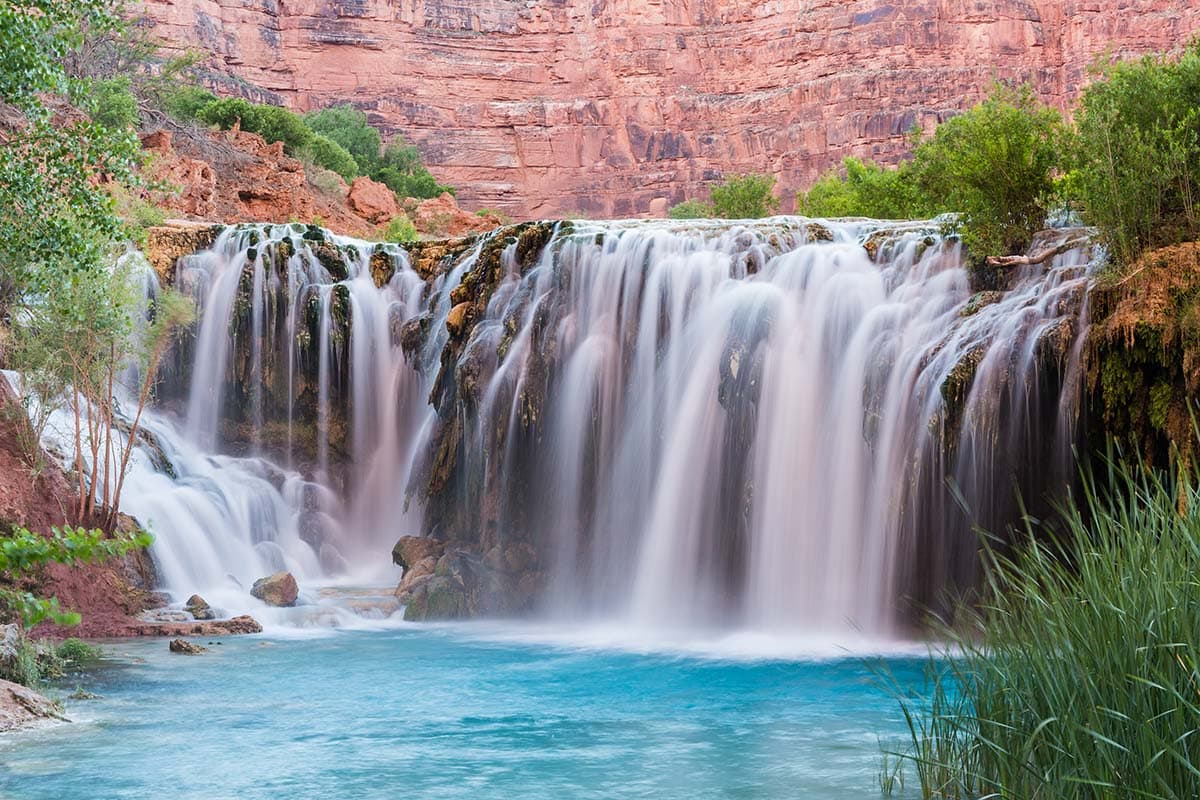
Located directly adjacent to the Havasu Canyon Trail, this is the first Havasupai waterfall that most visitors see — unless they know to take the spur trail to Fifty Foot Falls a quarter-mile earlier. Rock Falls was also “created” during the 2008 flash flood, and is also commonly called Little Navajo Falls — and is often mistakenly called Fifty Foot Falls due to its proximity to its nearby neighbor.
Rock Falls is a popular place to go cliff jumping (jump at your own risk), as the 30-foot drop into a fairly deep pool is “safer” than most other jumping options in Havasupai. From the Hualapai Hilltop Trailhead, it’s an 9.3 mile one-way hike to reach this waterfall.
Related Read: 17 Best Arizona Swimming Holes to Hit This Summer
3. Havasu Falls
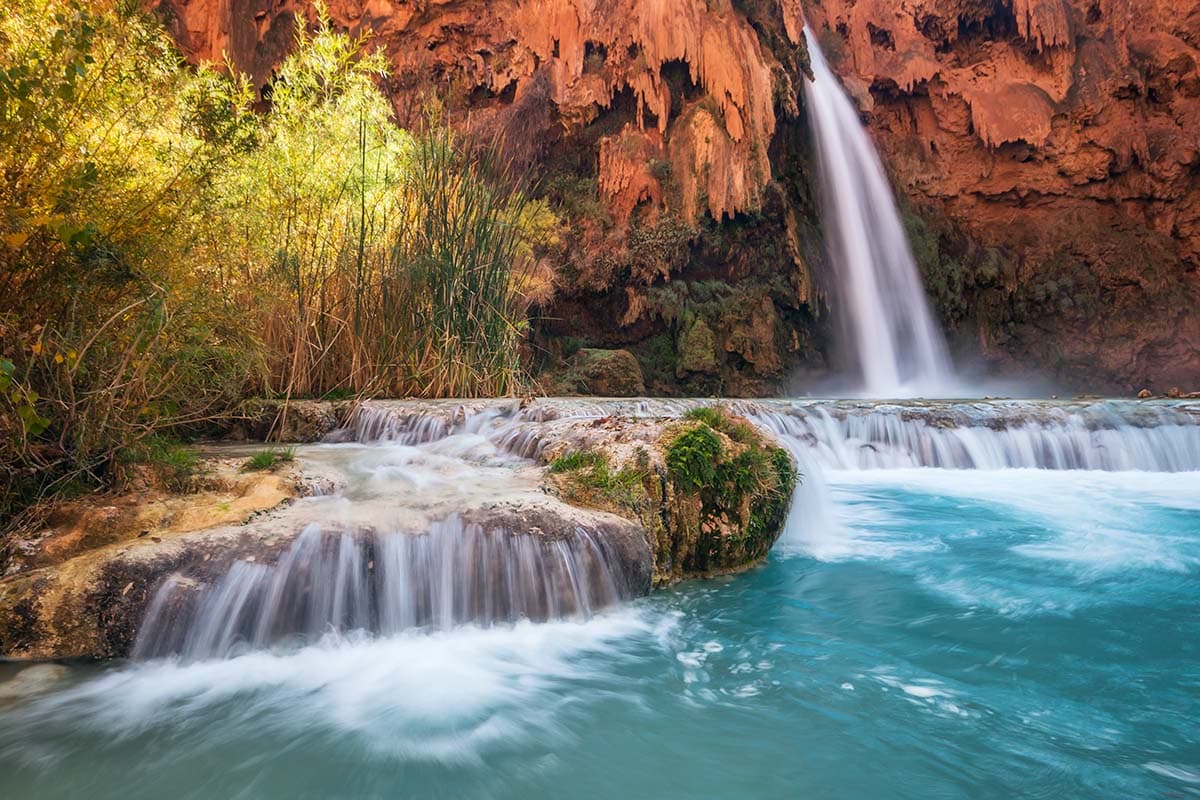
Arguably the most beautiful and most famous of the Havasupai waterfalls, Havasu Falls tumbles 90 feet from a travertine chute into a plunge pool ringed with smaller cascades. With Havasupai’s insane popularity, don’t expect to ever have this waterfall to yourself.
Located at the northern end of the Havasupai campground, reaching Havasu Falls requires hiking in 10 miles from Hualapai Hilltop. If you can manage to get a future permit for Havasupai, reaching the paradise that is Havasu Falls makes it all worth it.
Related Read: 12 Magical Glamping Sites Near the Grand Canyon South Rim
4. Mooney Falls
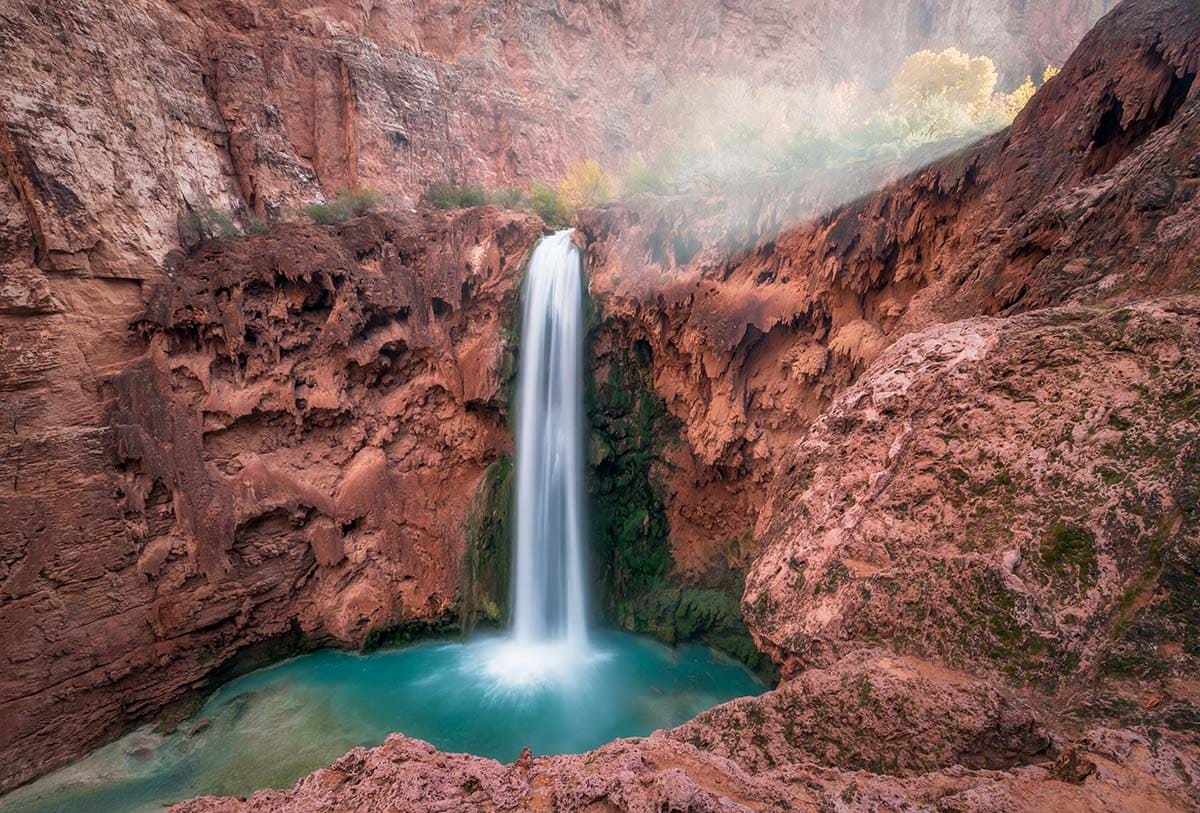
The infamous Mooney Falls makes it home at a dramatic red rock amphitheater where Havasu Creek falls abruptly off of a 190 foot tall cliff. While Havasu Falls is perhaps a little more photogenic, Mooney holds its own as a hauntingly beautiful sight to see. The two waterfalls are often confused with each other due to their similarities.
Located just past the lower end of the Havasupai campground, Mooney Falls is approximately 1 mile downstream from Havasu Falls, and 11 miles via trail from Hualapai Hilltop. Reaching the bottom of Mooney Falls requires a treacherous and often exposed descent down the cliff face on a series of tunnels, ladders, and steep staircases.
Related read: 8 Best Hikes on Grand Canyon’s South Rim
5. Beaver Falls
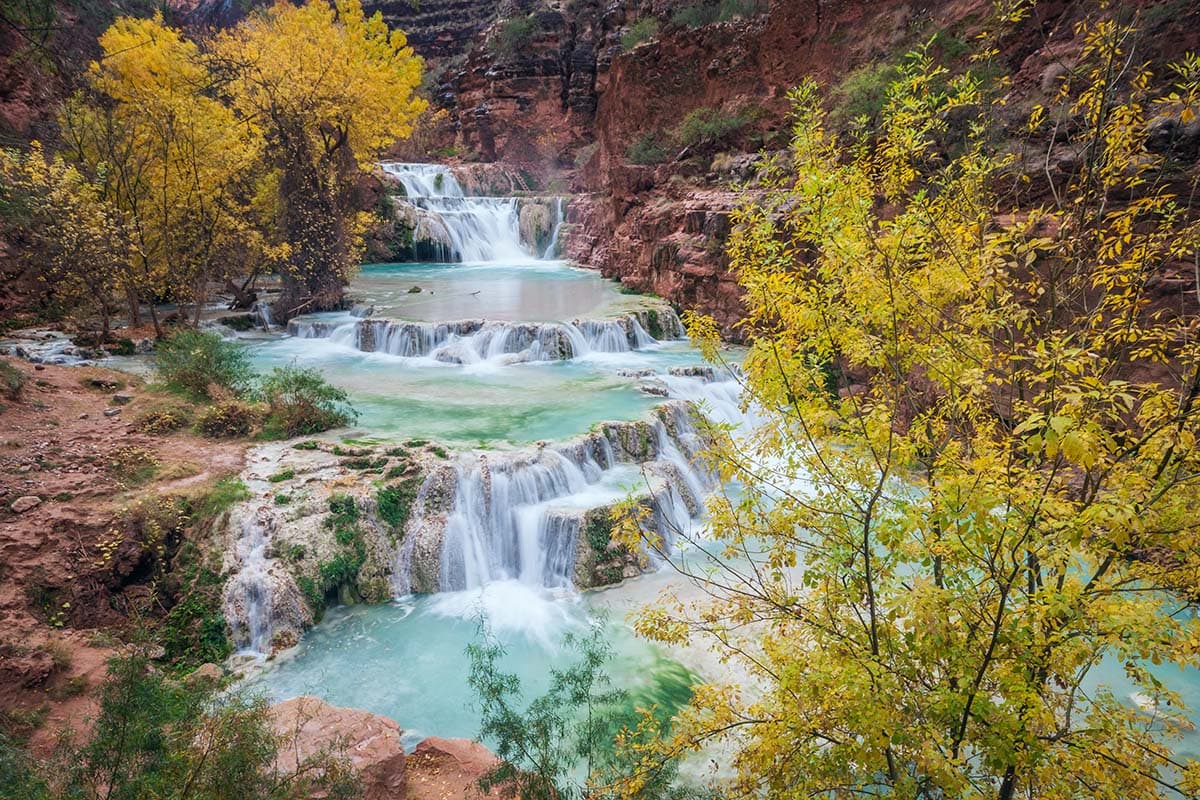
The last of the Havasupai waterfalls, Beaver Falls is a series of four stair-stepped travertine cascades, making for the ultimate multi-tiered swimming hole. Arguably the safest area for cliff-jumping, Beaver Falls feels almost like a miniature waterpark.
Beaver Falls is most often visited as a 6-mile round-trip “day hike” by overnight hikers staying at the Havasupai campground. From Hualapai Hilltop, it’s 14 miles one-way to get to Beaver Falls. Some visitors to Beaver Falls are rafters that make the 7-mile round-trip day hike up Havasu Creek from Colorado River.
Related Read: Best Stops on a Las Vegas to Grand Canyon Road Trip
6. Ribbon Falls
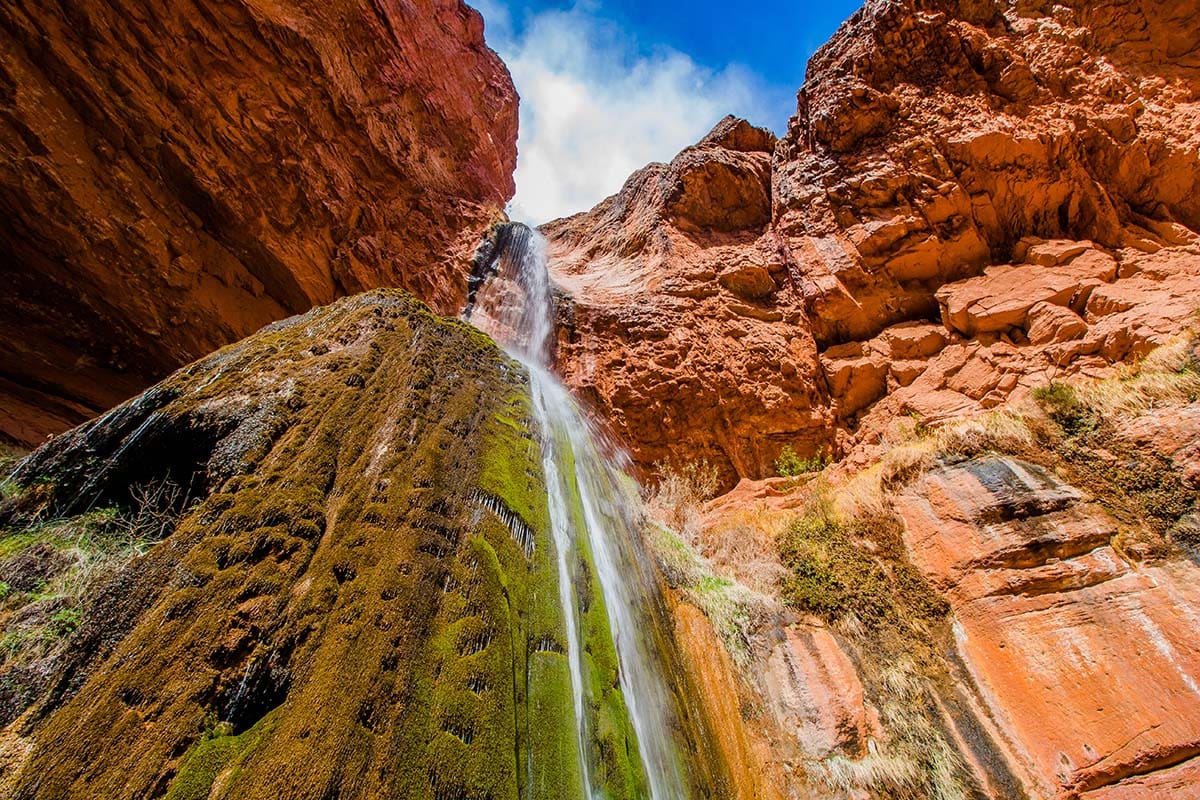
The rest of the waterfalls on this list are all within Grand Canyon National Park, starting off with the classic Ribbon Falls. Located just off of the North Kaibab Trail (yes, along the infamous Rim-to Rim hike), Ribbon Falls is one of the more accessible waterfalls in the National Park. The spring-fed creek is charged with calcium-carbonate (similar to Havasu Creek), which has formed a large travertine dome at the base of the waterfall, giving Ribbon Falls its own unique trademark.
The simplest way to access Ribbon Falls is by day hiking the North Kaibab Trail — 14 miles round-trip. If attempting a Rim-to-Rim hike, you might also take the half-mile detour to Ribbon Falls. Overnight hikers staying at Bright Angel Campground or Phantom Ranch often “day hike” to Ribbon Falls, which is 12 miles round-trip. No matter which was you slice it, Ribbon Falls requires effort to be reached.
Editor’s Note: As of this writing, access to Ribbon Falls is closed. NPS removed the damaged bridge that connects the North Kaibab to Ribbon Falls. Check with the Grand Canyon National Park trail closures report for current information on when the bridge may reopen.
7. Deer Creek Falls
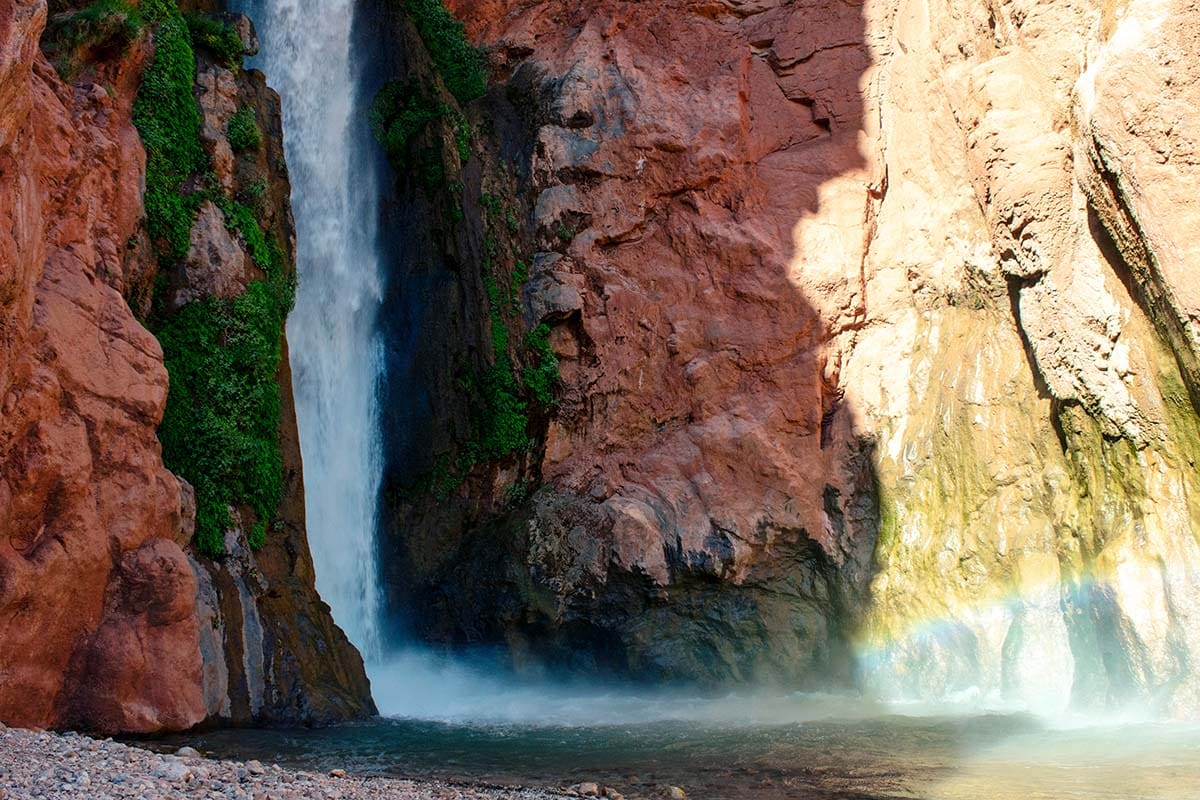
Most often accessed by river rafters — but sometimes by dedicated backpackers — Deer Creek Falls is one of the most remote waterfalls in the Grand Canyon. While rafting requires multiple days on the river, the hike from the Colorado up to the falls is a mere quarter-mile. Of course, it’s well worth a little extra extra to scramble the one mile above the falls and explore Deer Creek Narrows, where the creek winds through a sculptured slot canyon.
For backpackers, this is one the most challenging on-trail hikes in Grand Canyon, for expert canyon hikers only. The shortest route to Deer Creek Falls is almost 10 miles one-way via the Bill Hall Trail, but crosses a rugged, dry, inhospitable stretch of desert that often punishes hikers not prepared for its adversity.
Related Read: 10 Best Backpacking Trips in Grand Canyon National Park, Arizona
8. Thunder Falls
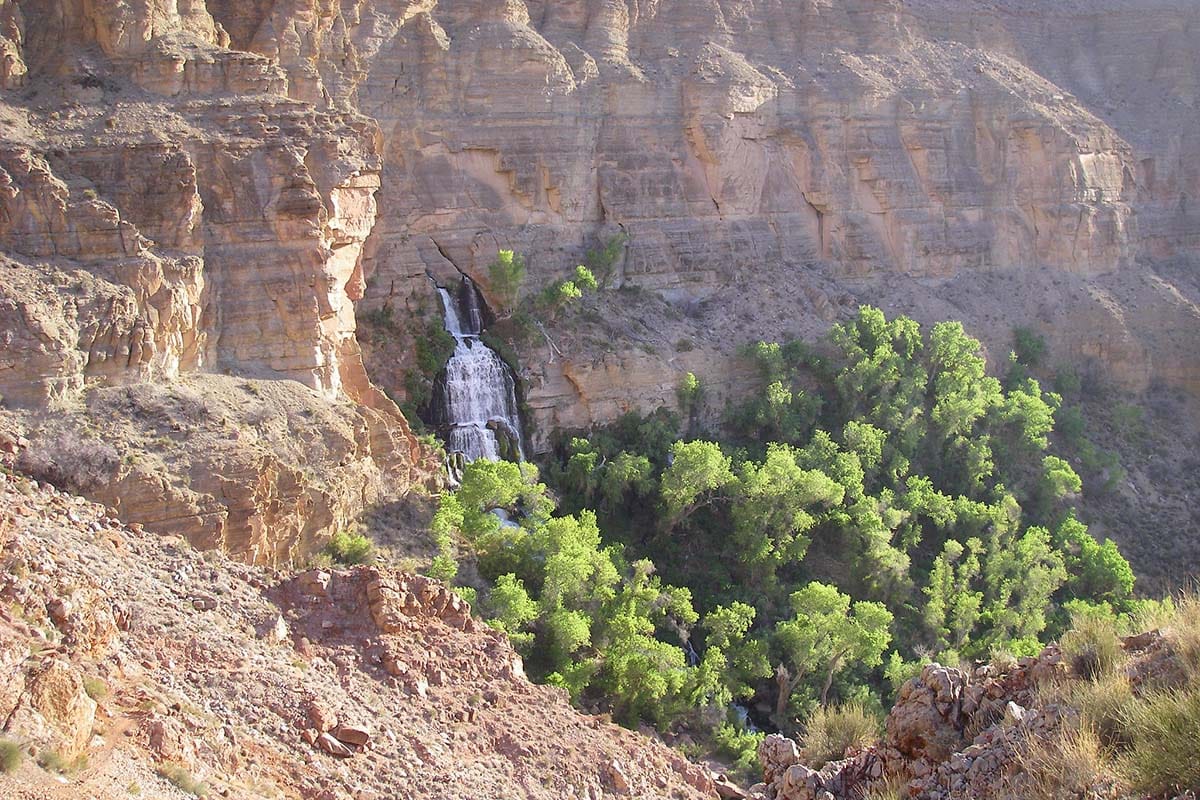
Thunder Spring — the source of Thunder River — is a dramatic location where gallons of water erupt every second out of a Redwall Limestone cliff. As the river tumbles down the nearby ledges and cliff faces, it’s known as Thunder Falls. There is no other sight quite like it in the Grand Canyon, and requires an incredible effort to be reached.
Thunder Falls is most commonly accessed via the Bill Hall Trail or the longer Thunder River Trail. The shortest distance from trailhead to the base of falls is approximately 7 miles of rugged and hot desert hiking. Most backpackers visit Thunder River in conjunction with Deer Creek (see Deer Creek Falls above) and Tapeats Creek, making for an epic expert’s-only loop hike.
Related Read: 8 Best Grand Canyon Hiking Tour Companies
9. Elves Chasm
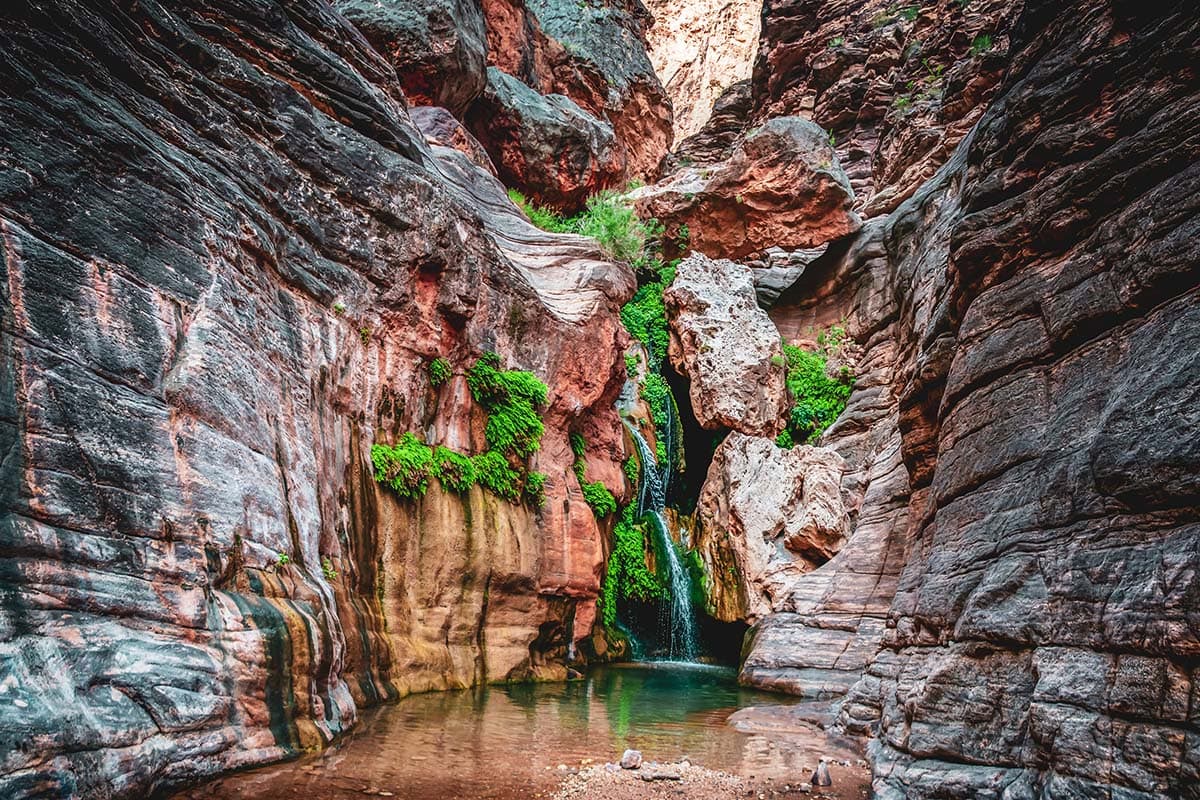
One of the most famous photography spots in Grand Canyon National Park, Elves Chasm is an idyllic slot canyon grotto decorated with ferns and a trickling waterfall. Notoriously hard to get to, most visitors get to the Chasm while on a rafting trip — although its still a rugged two mile round-trip hike with some scrambling and un-roped rock climbing required.
Non-rafters can also reach Elves Chasm, but it requires one of the most dangerous and demanding off-trail backpacking trips available in Grand Canyon. Completing the Royal Arch Route gives access to Elves Chasm, clocking in at 33 miles — including the two mile side trip to Elves Chasm. Of course, Royal Arch’s 33 miles is even harder than the mileage sounds, as it requires extensive off-trail route-finding and bush-whacking plus numerous sections of exposed climbing and a 20-foot rappel.
Related Read: An Adventurous Los Angeles to Grand Canyon Road Trip Itinerary
10. Hermit Creek
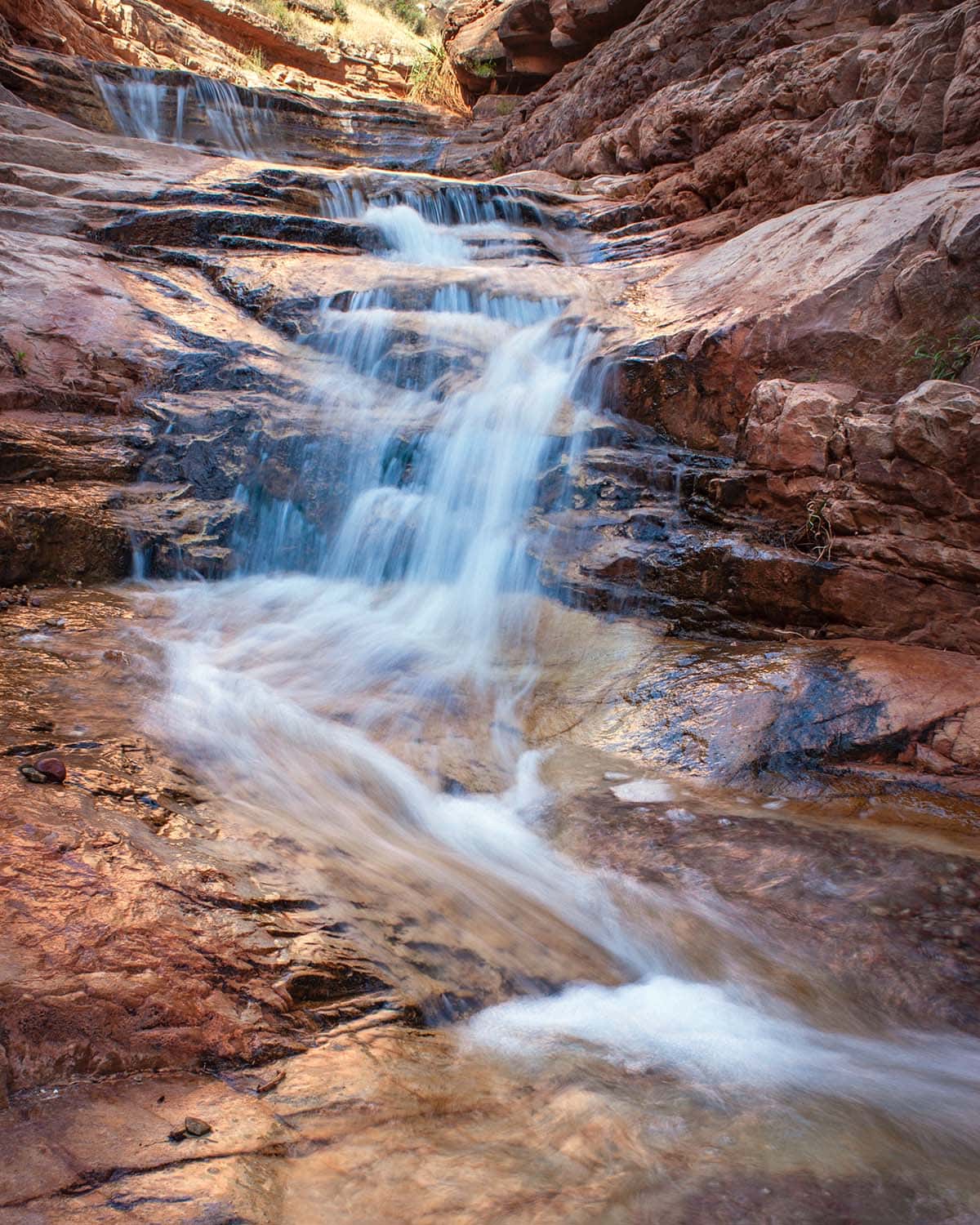
Just below the Hermit Creek Campground you’ll find a pair of photogenic cascades as the creek tumbles through the Tapeats Sandstone. I had no idea this small waterfall existed until I came across it while hiking the Tonto Trail from Boucher Creek to Hermit Creek, but it immediately became one of my favorite spots in Grand Canyon.
The shortest way to get to what I like to call “Hermit Falls” is straight down the Hermit Trail — 8.2 miles one-way. Technically this can be done as a day hike, but the National Park Service recommends overnighting as a safer alternative, and this waterfall sure is easy to enjoy when you’re camping at Hermit Creek Campground.
11. Garden Creek
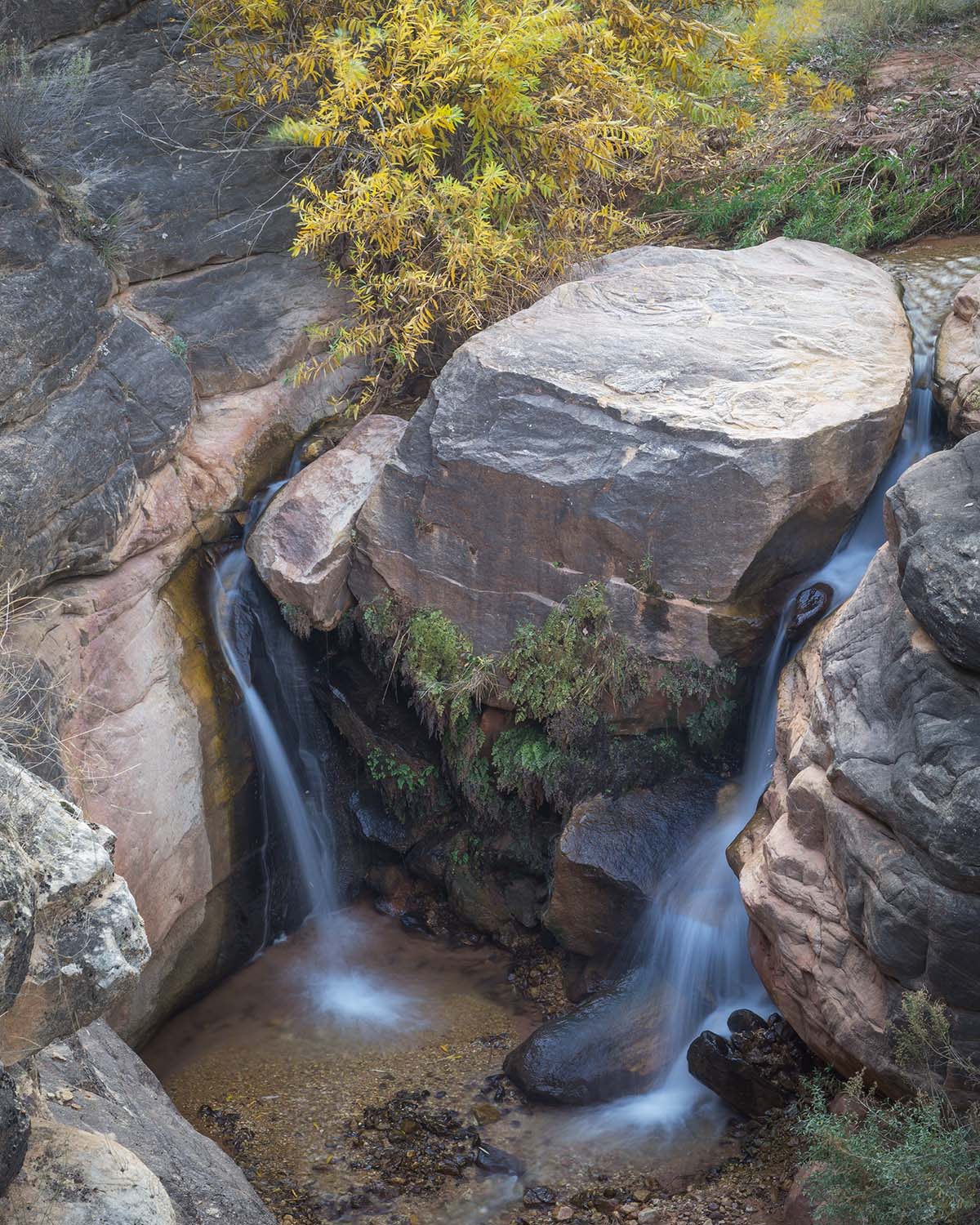
The small trailside waterfall pictured above isn’t really a destination in itself, but makes for a wonderful spot to take snack break while hiking the Bright Angel Trail. Located in the Tapeats Sandstone just above the Devil’s Corkscrew, this makes for a natural break spot when hiking out from the Inner Gorge.
Of course, there are more waterfalls to be seen in Garden Creek, but require a technical canyoneering excursion to visit. Yes, we’re talking about ropes and harnesses and rappels down waterfalls — so don’t undertake this without professional help, unless you are, you know, and experienced technical canyoneer. Consider inquiring with some of Arizona’s top canyoneering guide services for availability to take you through Garden Creek.
12. Cheyava Falls
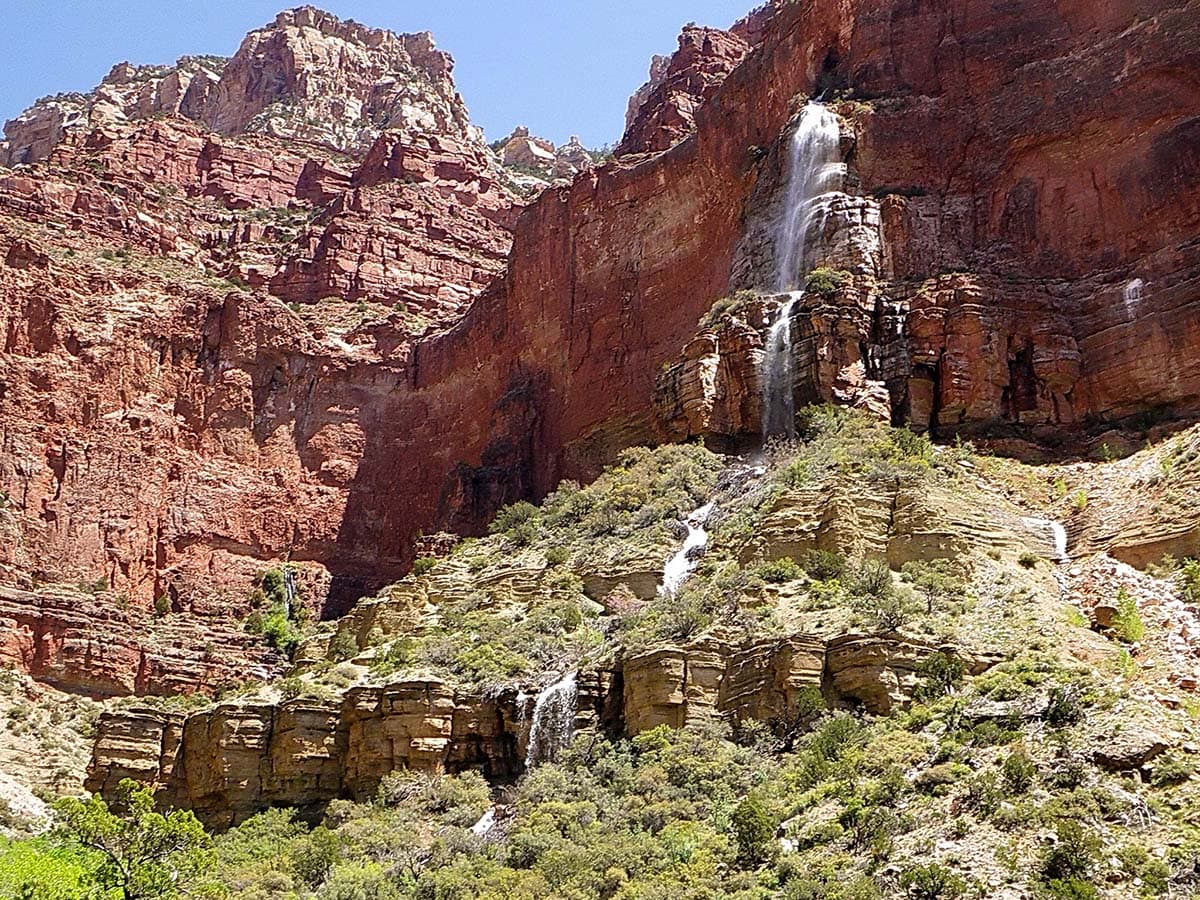
The granddaddy of Grand Canyon waterfalls — Cheyava Falls is not only the tallest waterfall in Grand Canyon — it’s the tallest waterfall in the state of Arizona. The caveat here is Cheyava Falls is a seasonal waterfall, so it is normally dry and only flows when there is significant snowmelt or thunderstorm activity at the head of its canyon.
If Cheyava Falls is flowing well, it can be seen from some locations on the Grand Canyon South Rim, some 10 miles away. To get up close and personal with Cheyava, you must be ready to punish yourself on a long expert’s-only backpacking trip. Just to get to camp, Cheyava-seekers must hike down South Kaibab Trail (6.5 miles), take North Kaibab Trail (1.2 miles) to the rough Clear Creek Trail (8.5 miles) — for a total of 16.2 arduous miles. From camp, it’s another 3.3 miles of rugged off-trail bush-wacking to the base of Cheyava Falls — long and hard but worth it for those willing to make the journey.
Related Read: 12 Best Hikes in Arizona, From Desert to Tundra
13. Vasey’s Paradise
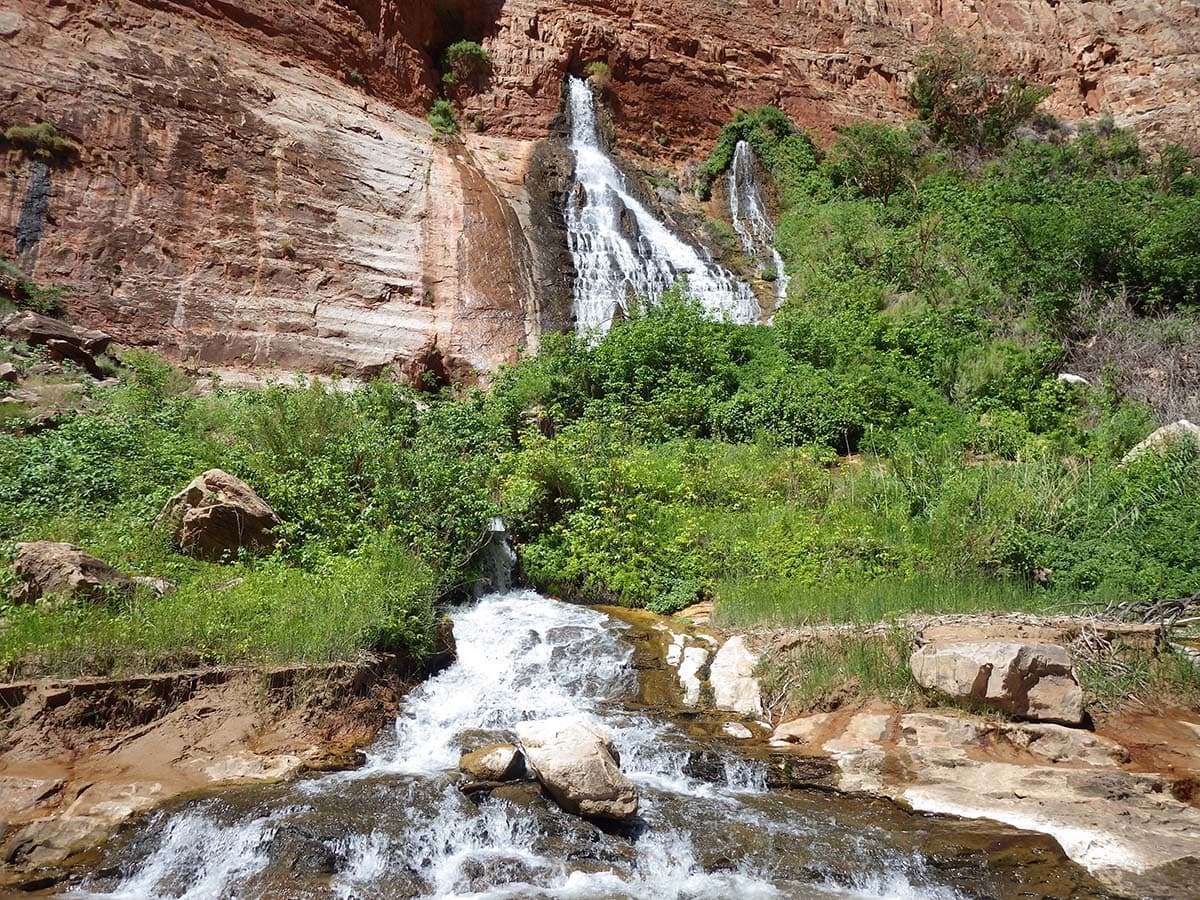
Located in Marble Canyon (the uppermost section of Grand Canyon), Vasey’s Paradise is yet another location where a waterfall is created by a spring popping out of a cliff face. But this one happens to be right next to the Colorado River — easily viewable even while floating by in a raft. You’ll get a least a good glimpse of Vasey’s on even the shortest rafting trips in the upper canyon.
Of course, most river trips stop at Vasey’s Paradise so rafters can enjoy this desert oasis, requiring walking only a few steps out of the boat. Use care when exploring this waterfall as it is one of two known habitats of an endangered species: the Kanab ambersnail.
Explore the Grand Canyon State
Get epic travel ideas delivered to your inbox with Weekend Wanderer, our newsletter inspiring more than 10,000 readers every week.
Seen in: Arizona, Grand Canyon, Hikes, National Parks, Southwest

